When Dutch masterpieces travel around the world, they travel in a Turtle
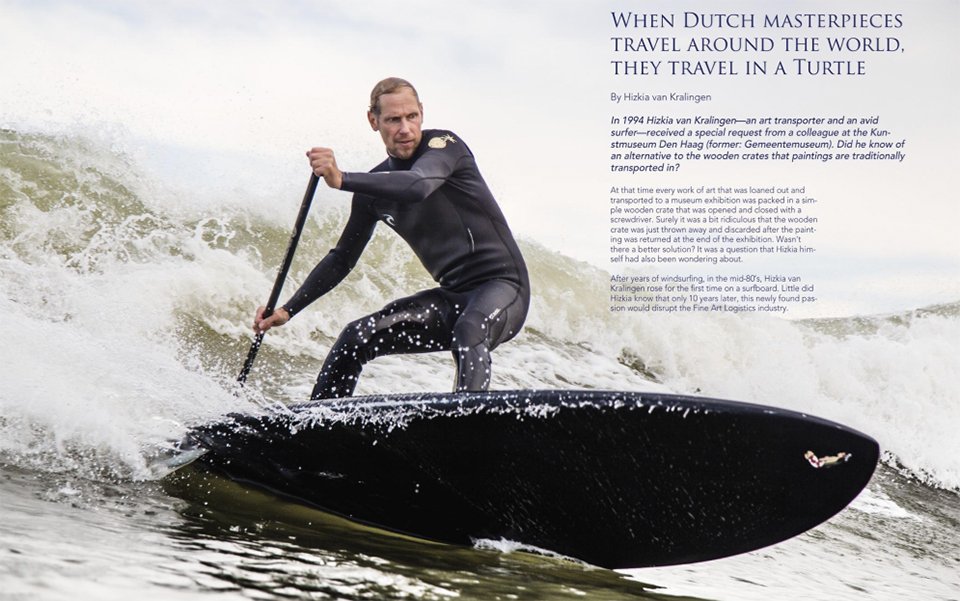
The International Institute for Conservation of Historic and Artistic Works (IIC) has featured an article on Turtle in the June-July 2021 edition of their online magazine, News in Conservation. What a great read!
The article gives a brief history of Turtle, the evolution of the Turtle, from the original yellow Turtle to the green Turtle uNLtd and the development of our latest line extension; the advanced corner block T+. The article further emphasises the sustainability and durability of the Turtle. Many thanks to the IIC!
Read the article here or read the article below.
In 1994 Hizkia van Kralingen—an art transporter and an avid surfer—received a special request from a colleague at the Kunstmuseum Den Haag (former: Gemeentemuseum). Did he know of an alternative to the wooden crates that paintings are traditionally transported in? At that time every work of art that was loaned out and transported to a museum exhibition was packed in a simple wooden crate that was opened and closed with a screwdriver. Surely it was a bit ridiculous that the wooden crate was just thrown away and discarded after the painting was returned at the end of the exhibition. Wasn't there a better solution? It was a question that Hizkia himself had also been wondering about.
After years of windsurfing, in the mid-80’s, Hizkia van Kralingen rose for the first time on a surfboard. Little did Hizkia know that only 10 years later, this newly found passion would disrupt the Fine Art Logistics industry. In response to the request of the Kunstmuseum Den Haag, Hizkia imagined an art transport crate that was like a surfboard: hard on the outside and soft on the inside. Van Kralingen had a crate made by two surfboard technicians, with tough polyester armour on the outside and foam on the inside. At its heart was a wooden plate that absorbs condensation when the temperature changes. That foam-encased wooden panel was suspended inside the crate, maximizing the vibration absorption, and four adjustable corner blocks fixed with Velcro meant that paintings of any size could be securely and safely held in place. The Turtle was born.
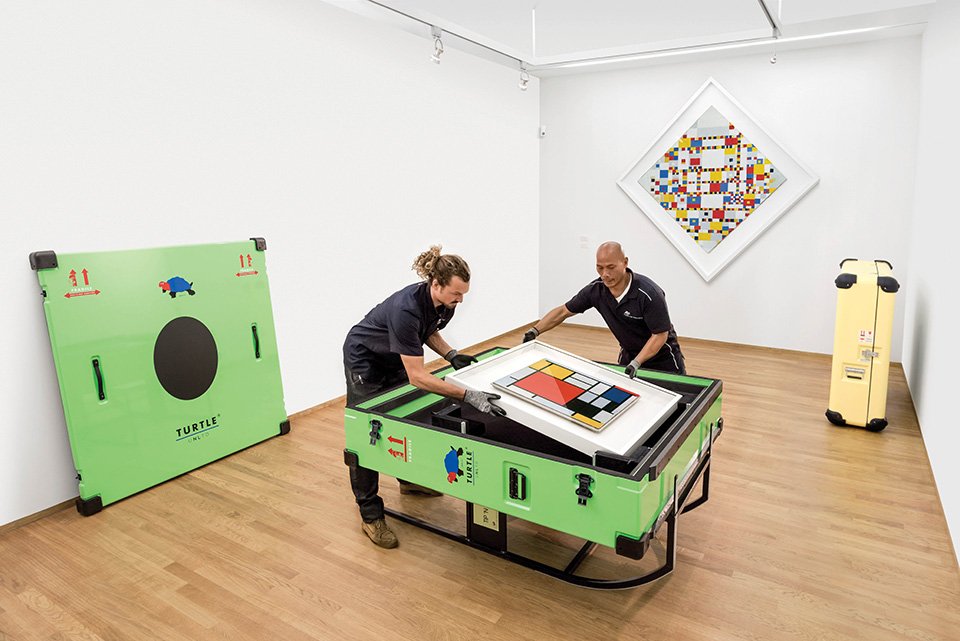
Seventy Mondrian paintings
The Municipal Museum in The Hague decided to immediately order one hundred Turtles. In 1994 seventy Mondrians from their collection were transported in Turtle crates to MoMA in New York and the National Gallery of Art in Washington DC. Four years later the Van Gogh Museum decided that it too would only send its paintings around the world in Turtles.
For almost thirty years Turtles have been used by museums around the world for safely transporting their most valuable artworks, from Vermeer’s Milkmaid to Mondrian’s Victory BoogieWoogie and Rembrandt’s Portrait of an Elderly Man. There are a number of progressive museums in the Netherlands—such as the Van Gogh Museum, the Kröller-Müller Museum and the Kunstmuseum Den Haag—who have embraced the Turtle as the better alternative to wooden crates, and virtually all of the museums in the Netherlands are now familiar with Turtles. As Van Kralingen says, “When Dutch masterpieces travel around the world, they travel in a Turtle.”
Every month Hizkia Van Kralingen (the name of his eponymous logistics company; Turtle is a separate entity) is involved in the logistics for at least one hundred exhibitions worldwide, and it’s all done with military precision; the artworks are loaded so that they’re aligned with the direction of flight to minimize vibration, and the pilot needs to be warned not to adjust the thermostat in the hold—everything must be precise because you don’t want the customs service to start opening the Turtles. To be sure, they’re a smoothly oiled machine.
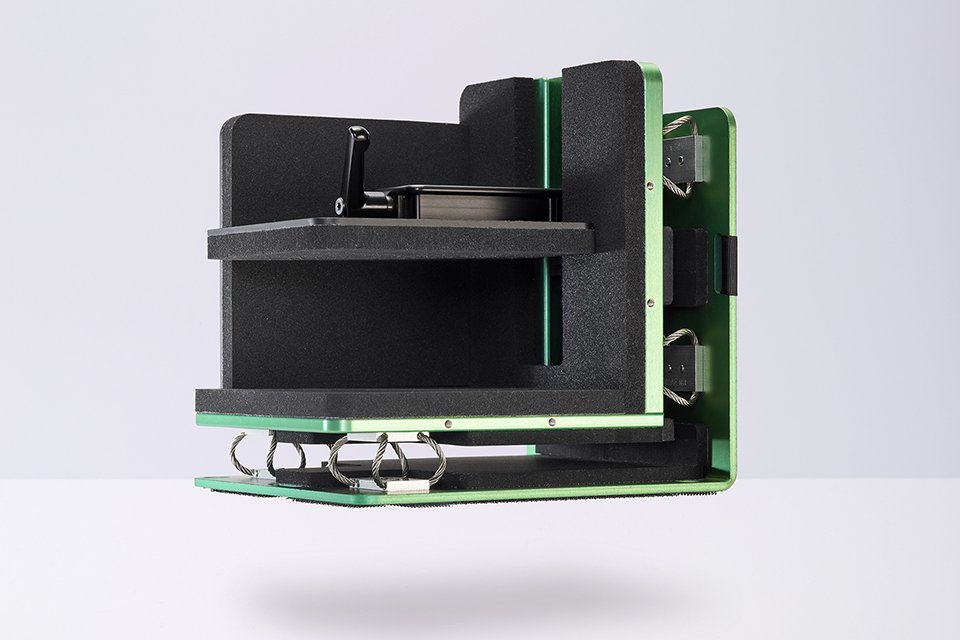
Shock, Humidity, Vibration
At any given moment, hundreds of artworks are in the course of being transported to locations around the world, and the volume of art transports only increases each year. The majority of artworks still travel in made-to-order wooden crates which are often used just once and then destroyed because museums lack sufficient space to store them which is, of course, not green at all. In a wooden crate, foam is used as a shock absorber and as a way of regulating humidity and temperature. But recently, intensive research has been carried out on the role and effect of vibration, and surprisingly, it turns out that foam is not such a suitable material after all.
“We are very pleased with the green Turtle uNLtd with its specifically-designed panels for regulating humidity and temperature,” says Geert Verhoeff, the business development manager at Turtle. “It’s a fantastic crate, but we knew there were more gains to be made in reducing vibration. Using wood can exacerbate vibration, particularly that caused by transport in trucks. The Turtle's rigid composite outer shell combined with the T+ [corner blocks] provides optimum vibration reduction without sacrificing shock absorption.”
The T+ corner blocks are outfitted with specially-constructed springs called wire rope isolators (WRIs), designed in cooperation with the German vibration expert Prof. Dr.-Ing. Kerstin Kracht; they are an integral part of the T+ corner blocks. They retain constant performance characteristics for over 30 years. The WRIs act as protection against shocks and vibration. Their exact positions inside the Turtle, the number of WRIs used and the thickness of the wires all determine the specific performance of each corner.
The L-shaped T+ block pieces are made of rigid aluminium and provide a solid base for the WRI. The T+ blocks are available in right-hand, left-hand and side variants and are held in place inside the Turtle by a special high-performance Velcro. The weight of the painting determines the number of T+ pieces needed for the optimum result.
The difference with the first generation of yellow Turtles and the (green) Turtle uNLtd is the use of vacuum insulation panels (VIP) as these panels have a high thermal resistance with the purpose of stabilizing temperature and humidity within the crates. “Now there’s the third step; the T+ vibration reduction. This is a massive step in the art transport world,” says Verhoeff emphatically. “It’s revolutionary. It expressly takes the actual weight of the artwork into account. This is something brand new, just from December 2020.”
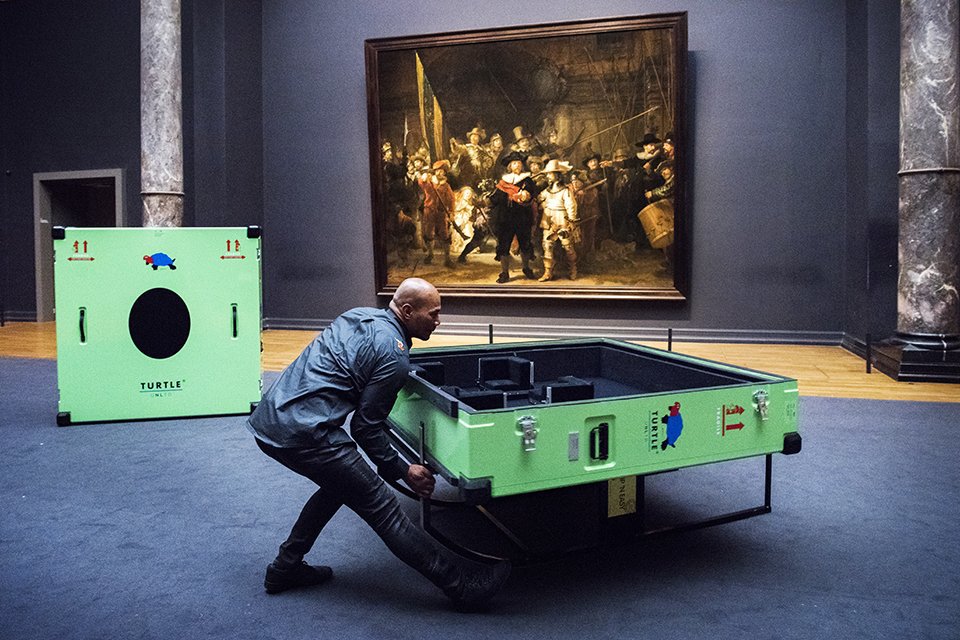
Sustainability
The first generation of Turtles are still used on a daily basis. “Nearly thirty years later! That shows how durable they are,” says Verhoeff. “There’s an ongoing overhaul project replacing the interior, foam, velour and Velcro which will increase a Turtle’s lifespan by another twenty years. We look at each individual part to see what needs replacing, but the shell remains intact.” This longevity means decades in which no separate wooden crates need to be made for works of art, saving more than two trees a year for each Turtle used. Some 600 Turtles are currently in circulation, having been used for approximately 2,000 exhibitions, which results in 25,000 trees having been saved so far.
Turtle sees it as their responsibility to provide a sustainable solution for transporting art. “It’s important that there’s no waste,” explains Verhoeff. “Over a very long time, you’re producing no waste. If you have to replace a component, it has no consequences for the outer shell and then you can keep using the Turtle for a few years longer. All of this helps cut down on CO2emissions. We’re also looking for ways of minimizing the use of soft wrapping such as bubble wrap, smooth plastic and a breathable, silky material called Tyvek.”
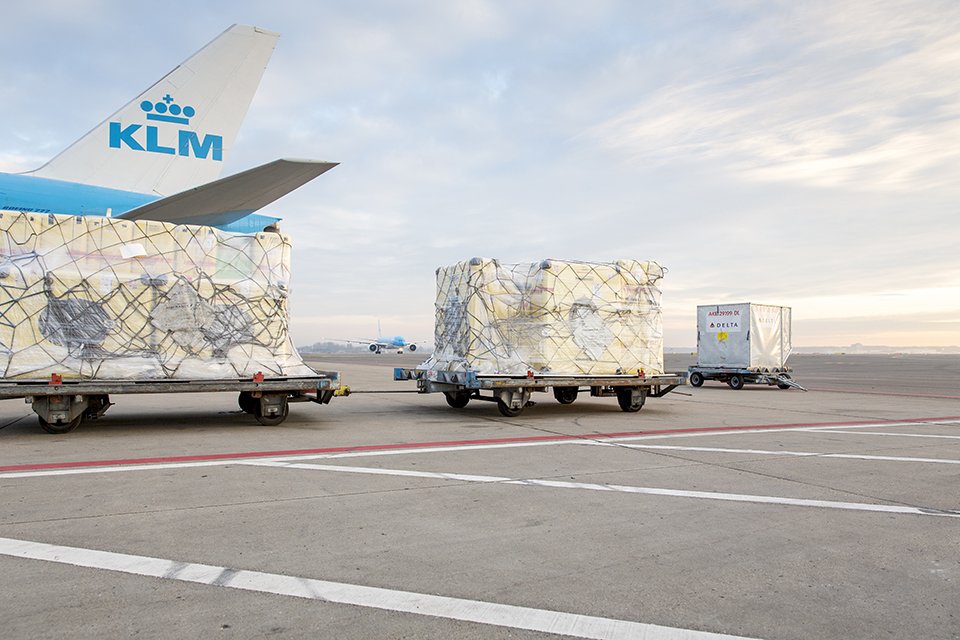
Coronavirus
In the world of art loans, there is an incredible amount of transport; a logistical operation in itself. “Global art transport has been affected by the coronavirus crisis we’re currently going through” says Verhoeff. “Everything’s been completely quiet for a while, although museums reopening does seem gradually to be appearing on the horizon. The question is whether we will shortly be able to continue on the same scale.”
Verhoeff thinks it would be great if there were a change in behaviour. “Museums that are still attached to using wooden crates are also slowly realizing that there are other options, like our rental crates. With so much scientific research underlying them, they are the best and most durable crates on the market today. Our main mission is to take care of our cultural heritage, just as restorers and museums do. A museum’s task is to exhibit its collection to the rest of the world; we want to help that happen, in a way that will still let it happen a century from now, as safely and sustainably as possible and with the least possible risk to the work itself.”
Turtle is now available worldwide through its network of international partners, and the headquarters are located in The Hague. For more information watch The Story of Turtle.
Bio Hizkia van Kralingen:
Hizkia van Kralingen (1967), born and raised in The Hague, was 22 years old when he founded the eponymous company in 1990, after taking over the museum clients of his family’s moving company ‘Van Kralingen’. Hizkia Van Kralingen provides logistics, art transport and collection management services to museums and private collectors worldwide. In 1994, Hizkia got inspired through his passion for surfing, and developed the safe, innovative and sustainable museum crate Turtle. Now 25 years later, Turtle is used all over the world and it is Hizkia's passion for art that continues to drive him to innovate in the field of sustainable art transport.
More news

